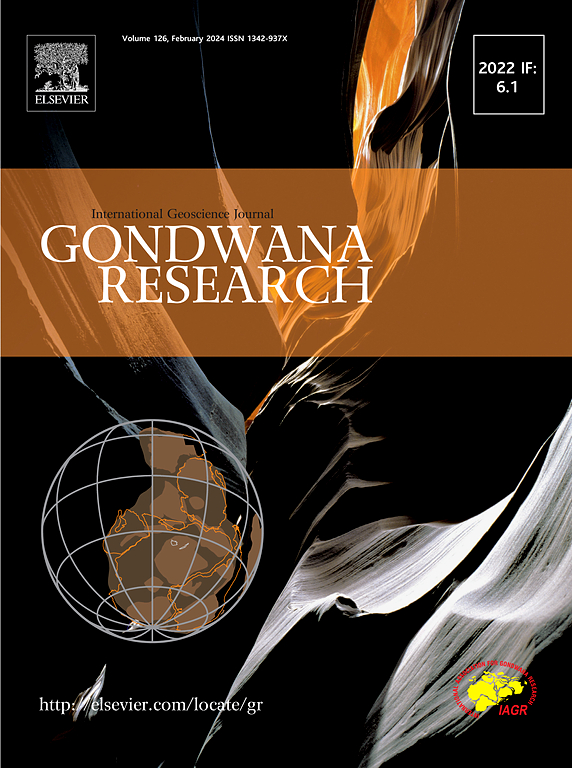Occurrence and enrichment mechanisms of helium in geothermal systems in continental China
IF 7.2
1区 地球科学
Q1 GEOSCIENCES, MULTIDISCIPLINARY
引用次数: 0
Abstract
Helium (He) is an indispensable and scarce strategic resource. We compiled 682 published He concentration and He–Ne–C–N isotopes data points for geothermal volatiles in continental China to systematically investigate distribution and enrichment mechanisms of helium in geothermal systems by linking fluid geochemistry with crustal structures, lithologies and thermal regimes. Active volcanic centres can be regarded as lower-priority helium provinces (He < 0.05 vol%), with up to 79 % of He from depleted MORB-type mantle. Samples with He concentrations up to standards for commercial He resources (He > 0.1 vol%) are widely distributed in the nonvolcanic geothermal systems, and can be classified as He-rich N2 type (81 %), He-rich CO2 type (15 %) or He-rich CH4 type (4 %) gases. Helium in nonvolcanic regions has a purely crustal or crustal–mantle complex origin, with subcontinental lithospheric mantle contributions of < 40 %. The widely distributed Proterozoic to Cenozoic granitic rocks are the dominant He source rocks, with average 4He production rates 2.0–7.2 times that of the average crust. He-rich gases in all tectonic units are characterized by 4He/N2 ratios of 0.001 to 0.44, likely formed by variable mixing of a crustal component (radiogenic 4He and He-associated N2) from granitic and metamorphic basements, and sedimentary (e.g., N2 and CH4) and atmospheric (i.e., N2 and 20Ne) components at shallow levels. In addition to these processes, in the Tibetan Plateau and eastern China, CO2 derived from mantle and metamorphic decarbonation at depths > 10–11 km can strip He generated and accumulated in the crust, carrying it to shallow geothermal reservoirs along large-scale faults. Subsequent CO2 loss (93–99 % on average) by calcite precipitation and dissolution processes can enrich He and N2, forming He-rich N2 type gases. Extremely He-rich geothermal fields (He ≥ 0.5 vol%) are distributed mainly along the Indus–Yarlung suture zone, southern Tibet detachment system and Anninghe fault in the Tibetan Plateau, the Weihe Basin and local regions in eastern China due to the existence of favorable crustal structures, and are potential sites for future helium exploration.

中国大陆地热系统中氦的赋存与富集机制
氦是一种不可缺少的稀缺战略资源。通过将流体地球化学与地壳结构、岩性和热机制联系起来,对中国大陆已发表的682个地热挥发物He浓度和He - ne - c - n同位素数据点进行了整理,系统探讨了地热系统中氦的分布和富集机制。活火山中心可视为低优先级氦省(He <;0.05% vol%),其中高达79%的He来自枯竭的morb型地幔。样品中He浓度达到商业He资源标准(He >;在非火山地热系统中广泛分布,可分为富he - N2型(81%)、富he - CO2型(15%)和富he - CH4型(4%)气体。非火山地区的氦具有纯地壳或壳幔复合体的成因,次大陆岩石圈地幔对氦的贡献为<;40%。广泛分布的元古代—新生代花岗质岩是主要的He烃源岩,其平均4He产率是地壳平均4He产率的2.0 ~ 7.2倍。各构造单元富氦气体的4He/N2比值为0.001 ~ 0.44,可能是由花岗岩和变质基底的地壳成分(放射性成因的4He和与he相关的N2)与浅层沉积成分(如N2和CH4)和大气成分(如N2和20Ne)的可变混合形成的。除此之外,在青藏高原和中国东部,CO2来源于地幔和深部变质脱碳。10-11 km可将氦在地壳中产生并积聚,沿大型断层带至浅层地热储层。方解石析出和溶解过程导致的CO2损失(平均93 ~ 99%)可富集He和N2,形成富He N2型气体。极富氦地热田(He≥0.5 vol%)由于有利地壳构造的存在,主要分布在青藏高原、渭河盆地及中国东部局部地区的印度河-雅鲁藏布带、藏南拆离体系和安宁河断裂一带,是未来氦勘探的潜在场所。
本文章由计算机程序翻译,如有差异,请以英文原文为准。
求助全文
约1分钟内获得全文
求助全文
来源期刊

Gondwana Research
地学-地球科学综合
CiteScore
12.90
自引率
6.60%
发文量
298
审稿时长
65 days
期刊介绍:
Gondwana Research (GR) is an International Journal aimed to promote high quality research publications on all topics related to solid Earth, particularly with reference to the origin and evolution of continents, continental assemblies and their resources. GR is an "all earth science" journal with no restrictions on geological time, terrane or theme and covers a wide spectrum of topics in geosciences such as geology, geomorphology, palaeontology, structure, petrology, geochemistry, stable isotopes, geochronology, economic geology, exploration geology, engineering geology, geophysics, and environmental geology among other themes, and provides an appropriate forum to integrate studies from different disciplines and different terrains. In addition to regular articles and thematic issues, the journal invites high profile state-of-the-art reviews on thrust area topics for its column, ''GR FOCUS''. Focus articles include short biographies and photographs of the authors. Short articles (within ten printed pages) for rapid publication reporting important discoveries or innovative models of global interest will be considered under the category ''GR LETTERS''.
 求助内容:
求助内容: 应助结果提醒方式:
应助结果提醒方式:


